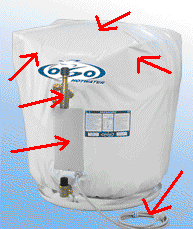 We have under the kitchen bench a 120 liter / 2000W electric water heater from http://www.oso.no/ Several spots outside this was warm to the touch, as indicated on the picture. I called technical support at Oso and they could confirm that it was OK to add extra insulation anywhere, also including the plastic lid that cover the ectrical wiring inside. So I used some spare insulation material and wrapped some plastice aound it all, and taped it up. For the pipes I got special insulation to wrap around the pipes. I have previously measured the standby energi consumption to be 1,8kWh/day. With the added insulation it as dropped to 1,2kWh/day. (You can measure the standby losses by measuring the energy used for a weekend when you are not at home using hot water. Use a plug in meter and just read off how many kWh that has been used to keep the water hot when you where gone).
We have under the kitchen bench a 120 liter / 2000W electric water heater from http://www.oso.no/ Several spots outside this was warm to the touch, as indicated on the picture. I called technical support at Oso and they could confirm that it was OK to add extra insulation anywhere, also including the plastic lid that cover the ectrical wiring inside. So I used some spare insulation material and wrapped some plastice aound it all, and taped it up. For the pipes I got special insulation to wrap around the pipes. I have previously measured the standby energi consumption to be 1,8kWh/day. With the added insulation it as dropped to 1,2kWh/day. (You can measure the standby losses by measuring the energy used for a weekend when you are not at home using hot water. Use a plug in meter and just read off how many kWh that has been used to keep the water hot when you where gone).We have the heater set at 65 C. Our family of five use about 7-8kWh a day for heating water.
I noticed how the power cord to the heater got warm when it was on. I cut off 1,2m of it for an additonal saving og about 4W ( 2,4m wire, 1mm2 copper, and about 8A) when in use :-)